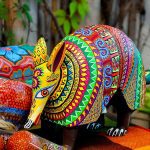By Mildred Boyd
The ancient Americans, like most primitive societies, worshipped and feared a huge pantheon of powerful beings who controlled every aspect of their lives. If a thing was worth bothering about there was a god for it, including Huix-tocihuatl, goddess of salt and Tlatolteotl, goddess of licentious-ness! There was even a special goddess of the maguey!
The four cardinal points, each with its special color, animals and gods, represented the four previous creations as symbolized by earth, air, fire and water. Our present, and frighteningly temporary, world is the fifth sun. Only Tezcatlipoca appears in all quadrants, though oddly at variance with the usual color associations. He is black in the white north, blue in the yellow west and white in the black south. Only in the red east does he deign to wear the right color. Deities associated with the south, gods and goddesses of the dance, drinking, pleasure, beauty and flowers, seem, on the whole, the most attractive lot.

Since pagan beliefs were much the same world-wide it is hardly surprising that many pre-Columbian deities have their counterparts in old-world mythologies. Nor was it a unique concept that the world had been destroyed four times, twice by flood, and would be destroyed again by cataclysmic earthquake at the end of some 52-year cycle. Concepts of afterlife, including 13 heavens and 9 hells, are startlingly similar. They even believed, like the Norse, in a “Valhalla” reserved for those who died in battle or childbirth. All others were required to spend at least some time in purgatory, though suicides were doomed there for all eternity. Tlalocan was a special paradise reserved for those sacrificed to Tlaloc or killed by lightning and, oddly, those who died of dropsy or skin diseases. Good souls rejoiced forever in the shade of the heavenly tree, Yaxche; bad ones suffered eternal torment in Mitnal. The rest awaited rebirth in Mictlan.
Air/Wind

Quetzalcoatl (Feathered Serpent) and his evil twin, Tezca-tlipoca (Smoking Mirror) engaged in a never-ending battle for control of the earth and its people. They represented the gentle and destructive winds and were symbolized by the planet Venus in its dual roles as Morning and Evening Star. Tolpiltzin Quetzalcoatl seems to have been a quasi-historical figure, a benevolent priest/king who became identified with the god and was tricked by Tezcatlipoca into committing the unforgivable sins of drunkenness and incest and shamed into self-exile in Yucatan.
The Mayan Kukulcan is identical with Quetzalcoatl.
War

Huitzilopotchtli (Hummingbird on the Left) was divinely born of Chalchiutlicue (Jade Petticoat) after that lady was touched by a falling feather. He immediately proved his prowess by defeating and killing his sister, Coyolxahqui (She of the Golden Bells) and his 400 brothers in battle. He seems to be the only god of purely Aztec origin and, along with Tlaloc, ruled their pantheon. He was also a sun god, but it was in his aspect as god of war that he demanded and received offerings of thousands of human hearts. The so-called Flower Wars were fought solely to obtain victims for his bloody altars.
Nacon was his Mayan equivalent.
Water

The long-nosed Mayan Chac and the Toltec/Aztec Tlaloc were agricultural gods who could, at will, nurture or destroy the crops upon which all life depended. Such powerful beings had to be constantly appeased with prayers and offerings lest they wreak vengeance. This was no idle fear for, according to their legends, Tlaloc and his sister, Chalchiuhtlicue, Goddess of Running Water, had each destroyed the world by inundation. In their kindlier aspect they ruled over their special heaven, Tlalocan.
Motherhood

In sheer number of offspring, if nothing else, Coatlicue (Serpent Skirt) was well qualified as patroness of expectant mothers. Miraculously impregnated by a piece of flint, she gave birth to 1,500 gods but any resemblance to the gentle Virgin Mary stops there. Magnificently hideous of aspect and wearing a skirt of writhing snakes and a necklace of severed human hands and skulls, she delighted in blood sacrifices.
Tlacolteutl, goddess of childbirth, and Akhushtal, her Mayan counter- part, seem to have been more amiable.
Moon

The Maya, especially, were obsessed with the study of the heavens. The Moon Goddess, Ix Chel, was very important since her waxing and waning determined planting and harvest times. In their mythology she was a young maiden who had a star-crossed love affair with the sun and is doomed for-ever to chase her lover across the sky, never to catch up with him. In her aspects as goddess of childbirth and weaving she was particularly worshipped by women.
Coyolxauhqui (She With Bells on Her Cheeks) served much the same functions for the Aztecs.
Sun

Like the wind, the sun has both benevolent and destructive powers. Maya Kinich Ahau is usually shown with large, squarish eyes, curlicue eye-brows and exaggerated cheekbones. The shape of his pupils, whether squares, spirals or crosses, indicated his different aspects. When he took the form of a macaw he was called Kinich Kakmo.
Aztec Tonatiuh, though actually a solar deity like Huit-zilopochtli, also had warlike attributes. He was patron of those elite warriors, the Eagle and Jaguar Knights.
Underworld

Since there were nine under-worlds, it follows that there were numerous gods associated with death, including those devoted to the punishment of specific classes of sinners. The chief deities were Aztec Mictlan-tecuhtli, who reigned over Mictlan, and Mayan Ah Puch, supreme ruler of Mitnal. In this case the Mayan version is the more fearsome. There was no hope of reprieve from his eternal hell and his statues often show him contemplating a human skull with all too obvious enjoyment.
Maize

Maize has always been the staple food of Mexico. As such, it required a number of gods to supervise every phase of its growth. Aztec Centeotl, son of that goddess of licentiousness, and Maya Um Kay were responsible for the mature crops while Xochipilli guarded the young maize. Special gods guarded the fields against destructive winds and rain.
Xochipilli and Um Kay are usually depicted as a beautiful youths, befitting their other aspects as gods of feasting, springtime, flowers and love.
Fertility

The rites of Xipe Totec (The Flayed God) were undoubtedly the cruellest though their purpose was beneficial. Humans sacrificed to him not only lost their lives but were literally stripped of their hides. The skins were then worn by the priests in ceremonies symbolizing the sacrifice of the fertility god, who had allowed himself to be flayed alive so that seedlings might like-wise shed their husks and escape the confining earth to produce the crops which sustained all life.
For more information about Lake Chapala visit: www.chapala.com



